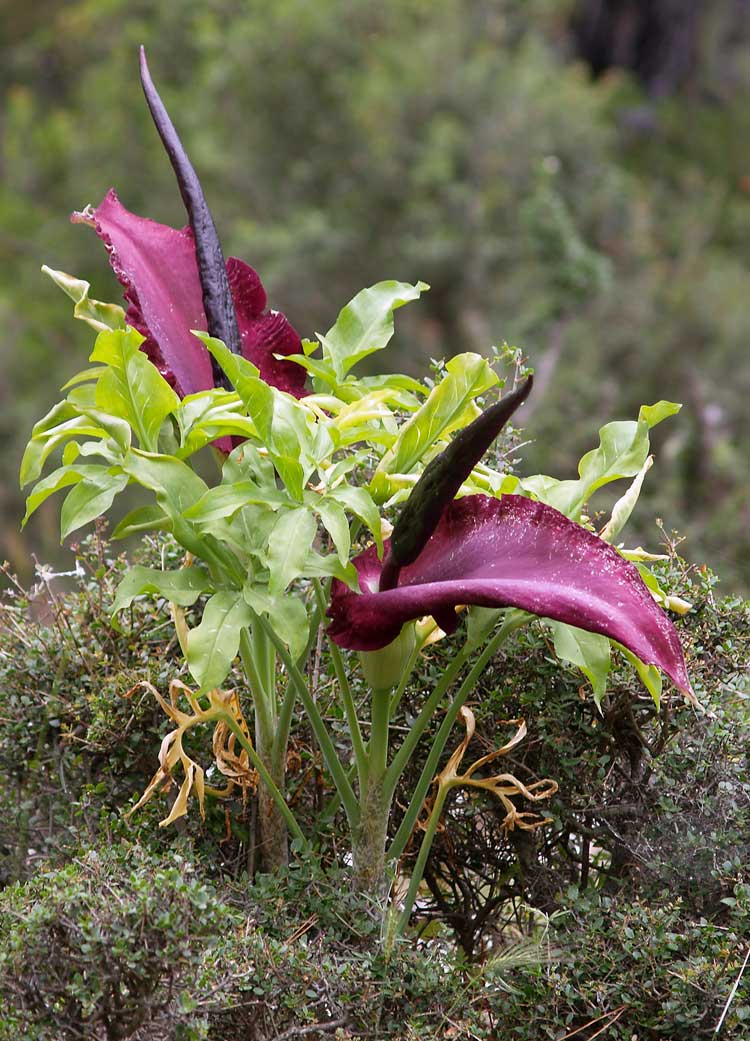
Dracunculus vulgaris (*)
Classification System: APG IV
Superregnum: Eukaryota
Regnum: Plantae
Cladus: Angiosperms
Cladus: Monocots
Ordo: Alismatales
Familia: Araceae
Subfamilia: Aroideae
Tribus: Areae
Genus: Dracunculus
Species: Dracunculus vulgaris
Name
Dracunculus vulgaris Schott in H.W.Schott & S.L.Endlicher, Melet. Bot.: 17. 1832. nom. nov.
Synonyms
Replaced synonym
Arum dracunculus L., Sp. Pl. 2: 964. 1753.
Type: “Habitat in Europa australi.” Not designated.
Homotypic
Arum guttatum Salisb., Prodr. Stirp. Chap. Allerton: 260. 1796, nom. superfl.
Dracunculus spadiceus Raf., Fl. Tellur. 3: 65. 1837, nom. illeg.
Aron dracunculum (L.) St.-Lag., Ann. Soc. Bot. Lyon 7: 119. 1880.
Dracunculus dracunculus (L.) Voss, Vilm. Ill. Blumengärtn., ed. 3, 1: 1166. 1895, nom. inval.
Heterotypic
Dracunculus major Garsault, Fig. Pl. Méd.: t. 250. 1764, opus utiq. oppr.
Dracunculus polyphyllus Blume, Rumphia 1: 124. 1836, nom. illeg.
Dracunculus creticus Schott, Prodr. Syst. Aroid.: 120. 1860.
Dracunculus vulgaris var. creticus (Schott) Nyman, Consp. Fl. Eur.: 754. 1882.
Dracunculus vulgaris subsp. creticus (Schott) K.Richt., Pl. Eur. 1: 173. 1890.
Dracunculus vulgaris var. elongatus Engl. in A.L.P. de Candolle & A.C.P. de Candolle, Monogr. Phan. 2: 603. 1879.
Dracunculus vulgaris var. laevigatus Engl. in A.L.P. de Candolle & A.C.P. de Candolle, Monogr. Phan. 2: 603. 1879.
Distribution
Native distribution areas:
References
USDA, ARS, Germplasm Resources Information Network. Dracunculus vulgaris in the Germplasm Resources Information Network (GRIN), U.S. Department of Agriculture Agricultural Research Service. Accessed: 08-Apr-12.
Govaerts, R. et al. 2016. Dracunculus vulgaris in World Checklist of Selected Plant Families. The Board of Trustees of the Royal Botanic Gardens, Kew. Published on the internet. Accessed: 2016 12 30. Reference page.
Dracunculus vulgaris is a species of aroid flowering plant in the genus Dracunculus and the arum family Araceae. Common names include the common dracunculus, dragon lily, dragon arum, black arum and vampire lily. In Greece, part of its native range, the plant is called drakondia, the long spadix being viewed as a small dragon hiding in the spathe.[1]
This herbaceous perennial is endemic to the Balkans, extending as far as Greece, Crete, and the Aegean Islands, and also to the south-western parts of Anatolia.[1]
Description
Male flowers (at top)
Female flowers (at the bottom).
The species is characterized by a large purple spathe and spadix, which has a very unpleasant smell reminiscent of rotting meat to attract flies (Lucilia and others) as pollinators. The large palmate leaves have occasional cream flecks along the veins.
The dragon lily has the ability to heat itself to a temperature of 18 degrees Celsius. This addition to its traits does not have any correlation to its potent scent, however it does promote the comfort of the insects who choose to pollinate on the lily.
Cultivation
Dracunculus vulgaris has been introduced to northern Europe, and North America, both to the United States, where it is present in the states of Kansas, Oregon, California, Washington, South Carolina, Tennessee, Kentucky, Michigan, Ohio, the commonwealth of Puerto Rico,[2] and to Canada, where it has been grown in the province of Ontario and Vancouver, B.C.
The plant can tolerate some shade but prefers full sun; it can also withstand drought but benefits from a little watering. The plant prefers a humus-rich, well-drained soil.
References
Dragon Arum Archived June 19, 2008, at the Wayback Machine at blueworldgardener.co.uk
PLANTS Profile for Dracunculus vulgaris (common dracunculus)
Retrieved from "http://en.wikipedia.org/"
All text is available under the terms of the GNU Free Documentation License

